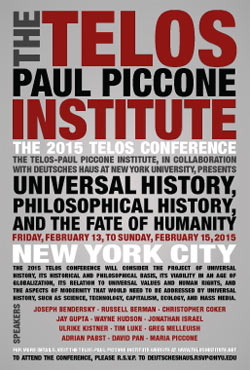 Transnational history has emerged in the wake of the sprouting of international history, global history, and post-colonial history as historical subject fields in the 1990s academic marketplace. Chris Bayly’s 2004 book Birth of the Modern World, 1780–1914 is a landmark in the emergence of transnational history as an academic subject stressing the connectedness of history, as a narrative of accelerating cross-border métissage and intercontextuality. As another historian in this school, Sven Beckert, reminds us, transnational history is more than an academic brand; it is a fundamentally different analytical space and a social movement in itself. On the cover of Bayly’s book is a portrait by Anne-Louis Giradet, student of Jacques Louis David, who would be exiled in Brussels after 1815 with Emmanuel Sièyes as revolutionaries turned supporters of Bonaparte. Ironically, it hangs in in the Trianon at Versailles. It is a portrait of Citoyen Jean-Baptiste Belley of Saint Dominique, native of the slave port of Gorée in Senegal, comrade-in-arms of Toussaint L’Ouverture and the first Black Deputy to both the National Convention and the National Assembly. Belley’s silk cummerbund and the decoration of his hat assert the universalizing intention of the French Revolution, His light breaches express the sexual power of Rousseau’s noble savage, and refer to Bayly’s emphasis on bodily regimes. Belley leans against a bust on a marble plinth: the bust of the Encyclopèdiste Raynal, the most radical critic of slavery and the colonial policy of the Ancien Régime.
Transnational history has emerged in the wake of the sprouting of international history, global history, and post-colonial history as historical subject fields in the 1990s academic marketplace. Chris Bayly’s 2004 book Birth of the Modern World, 1780–1914 is a landmark in the emergence of transnational history as an academic subject stressing the connectedness of history, as a narrative of accelerating cross-border métissage and intercontextuality. As another historian in this school, Sven Beckert, reminds us, transnational history is more than an academic brand; it is a fundamentally different analytical space and a social movement in itself. On the cover of Bayly’s book is a portrait by Anne-Louis Giradet, student of Jacques Louis David, who would be exiled in Brussels after 1815 with Emmanuel Sièyes as revolutionaries turned supporters of Bonaparte. Ironically, it hangs in in the Trianon at Versailles. It is a portrait of Citoyen Jean-Baptiste Belley of Saint Dominique, native of the slave port of Gorée in Senegal, comrade-in-arms of Toussaint L’Ouverture and the first Black Deputy to both the National Convention and the National Assembly. Belley’s silk cummerbund and the decoration of his hat assert the universalizing intention of the French Revolution, His light breaches express the sexual power of Rousseau’s noble savage, and refer to Bayly’s emphasis on bodily regimes. Belley leans against a bust on a marble plinth: the bust of the Encyclopèdiste Raynal, the most radical critic of slavery and the colonial policy of the Ancien Régime.
|
|
||||
|
Telos Press Publishing · PO Box 811 · Candor, NY 13743 · Phone: 212-228-6479 Privacy Policy · Data Protection Copyright © 2025 Telos Press Publishing · All Rights Reserved |
||||


